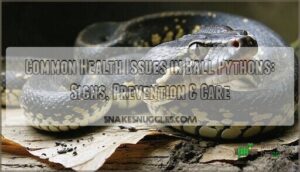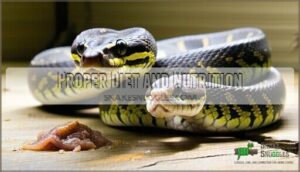This site is supported by our readers. We may earn a commission, at no cost to you, if you purchase through links.
 You’ll encounter several common health issues in ball pythons that require your attention.
You’ll encounter several common health issues in ball pythons that require your attention.
Respiratory infections top the list, showing as mouth breathing, wheezing, and mucus discharge.
Shedding problems happen when humidity drops below 50%, leaving stuck skin that can cut off circulation.
Mites appear as tiny moving dots, while scale rot creates dark, musty patches from excess moisture.
Parasites cause weight loss and excessive soaking behavior.
Poor feeding responses often signal stress or illness.
Most issues stem from incorrect temperatures, humidity, or dirty enclosures.
Your snake’s appetite, breathing patterns, and skin condition tell the whole story about their health.
Table Of Contents
- Key Takeaways
- Ball Python Health Issues
- Common Ball Python Diseases
- Ball Python Nutritional Health
- Ball Python Environmental Requirements
- Ball Python Preventive Care
- Frequently Asked Questions (FAQs)
- What health problems do ball pythons have?
- Are ball pythons healthy?
- What causes neurological problems in ball pythons?
- Does a ball python get worse if left untreated?
- Are ball pythons affected by inclusion body disease?
- Are ball python bites dangerous?
- Do ball pythons have a lot of health issues?
- What is the average life expectancy of a ball python?
- How can you tell if your ball python is dying?
- What are the early signs of mouth rot ball python?
- Conclusion
Key Takeaways
- Monitor your snake’s breathing patterns daily – respiratory infections show up as wheezing, mouth breathing, and mucus discharge, requiring immediate veterinary attention before they become fatal.
- Maintain proper humidity levels between 50-70% – low humidity causes stuck shed that can cut off circulation, while excess moisture leads to scale rot and bacterial skin infections.
- Keep your enclosure clean and temperatures consistent – most health problems stem from poor husbandry rather than complex diseases, so daily monitoring prevents costly emergency vet visits.
- Watch for early warning signs like appetite loss, lethargy, or unusual behaviors – catching issues early through regular observation makes treatment more effective and less expensive than waiting for symptoms to worsen.
Ball Python Health Issues
Your ball python’s health depends on recognizing early warning signs of common problems before they become serious.
These issues often stem from improper husbandry, but with the right knowledge, you can spot trouble early and take action.
Respiratory Infections
When respiratory infections strike your ball python, you’ll notice telltale signs like wheezing and open-mouth breathing.
Listen closely—your ball python’s labored breathing is nature’s urgent alarm bell ringing.
These snake respiratory infections often stem from bacterial pathogens, nidovirus infection, or fungal pathogens affecting your pet’s respiratory health. A key factor in these infections is often related to environmental parameter issues.
Watch for these critical symptoms:
- Nasal discharge with visible bubbles or mucus
- Clicking or whistling sounds during breathing
- Lethargy combined with loss of appetite
Ball python health depends on proper temperature gradients and humidity levels. Pneumonia develops when husbandry fails, making early veterinary intervention essential for your snake’s recovery.
Dysecdysis
When your ball python’s shedding goes wrong, you’re dealing with dysecdysis—incomplete skin shedding that can spell trouble.
This condition occurs when humidity levels drop below 50% or temperatures aren’t properly maintained.
Watch for retained eyecaps and stuck shed around the tail tip.
| Common Signs | Prevention Tips |
|---|---|
| Patchy, incomplete shedding | Maintain 60-70% humidity |
| Retained eyecaps clouding vision | Provide humid hide box |
| Stuck shed on tail/toes | Monitor shedding frequency cycles |
Dermatitis
Looking at your ball python’s skin reveals important health clues.
Red, inflamed patches with blister-like lesions signal dermatitis, often caused by excessive moisture and poor hygiene.
These bacterial skin infections typically start along the belly, creating foul-smelling pustules that can become serious complications if untreated.
Preventing dermatitis requires clean, dry enclosures with proper temperature gradients.
The infection can be caused by opportunistic bacteria like Salmonella or Pseudomonas.
Dental Disease
While skin issues affect your python’s exterior, dental disease strikes at the mouth itself.
Stomatitis causes gum swelling, thick discharge, and oral infections that can spread systemically if untreated.
Watch for these stomatitis causes and symptoms:
- Swollen, bleeding gums with cheesy pus
- Thick mucus or foul odor from mouth
- Oral hygiene problems from mouth injuries
- Poor husbandry creating bacterial overgrowth
Treatment options include antibiotics and oral cleaning, while preventative care focuses on proper enclosure conditions and regular oral health monitoring to prevent dental disease.
Common Ball Python Diseases
Ball pythons can develop several serious diseases that require immediate attention from reptile veterinarians.
You’ll need to recognize early warning signs like breathing difficulties, mouth lesions, and unusual behaviors to prevent these conditions from becoming life-threatening, including recognizing unusual behaviors.
Inclusion Body Disease
Inclusion Body Disease (IBD) represents one of the most devastating viral infections affecting captive ball pythons.
IBD strikes without warning—this viral nightmare has no cure and spreads like wildfire through snake collections.
This highly contagious condition spreads through direct contact, contaminated equipment, and mites between snakes.
| IBD Symptoms | IBD Diagnosis | IBD Management |
|---|---|---|
| Star-gazing behavior | RT-PCR testing | Supportive care only |
| Loss of coordination | Tissue biopsies | Strict quarantine |
| Muscle tremors | Necropsy examination |
Euthanasia recommended.
Unfortunately, no cure exists for this fatal disease in ball pythons.
Infectious Stomatitis
Infectious stomatitis, commonly called mouth rot, strikes when oral bacteria multiply in your ball python’s mouth.
Poor husbandry creates perfect conditions for this painful infection. You’ll spot swollen gums, thick mucus, bleeding, or cheesy pus around the mouth area.
Stomatitis treatment requires antibiotics and thorough oral cleaning. Preventative measures include maintaining proper temperatures and clean enclosures to support ball python health.
Viral Infections
Viral infections pose serious threats to your ball python’s health.
Ophidian paramyxovirus (OPMV) causes respiratory distress, while inclusion body disease (IBD) triggers devastating neurological issues.
IBD progression includes star-gazing, tremors, and regurgitation.
Viral transmission occurs through contaminated equipment and direct contact.
Diagnosis challenges arise because symptoms vary widely. Unfortunately, no antiviral treatments exist—only supportive care helps manage symptoms.
External Parasites
Everyone knows those unwelcome hitchhikers can turn your snake’s home into a nightmare.
External parasites like mites and ticks feed on your ball python’s blood, causing serious health problems.
Key parasite threats include:
- Mite identification – Look for tiny moving dots, especially Ophionyssus natricis (snake mites)
- Tick removal – Use tweezers to extract these larger blood-suckers carefully
- Zoonotic potential – Some parasites can transmit diseases to humans.
Betadine baths can help manage external parasite infestations.
Parasite prevention beats treatment every time. Regular parasite control and proper enclosure maintenance keep these pests away.
Ball Python Nutritional Health
Your ball python’s nutritional health depends on more than just tossing a frozen mouse into their enclosure.
Proper feeding practices, including appropriate prey size and feeding frequency, prevent serious metabolic disorders and vitamin deficiencies that can quietly undermine your snake’s health.
Proper Diet and Nutrition
Your ball python’s carnivore diet centers on whole prey like mice and rats, thawed to room temperature.
Proper prey size matches your snake’s widest body section, while feeding schedules range from weekly to monthly based on age.
Quality reptile nutrition prevents nutritional deficiencies and ball python obesity.
Avoid overfeeding—it’s easier than you think to create chunky serpents!
Vitamin Deficiencies
While whole prey diets typically prevent nutritional deficiencies, poor prey quality or improper storage can create problems.
Vitamin A deficiency affects shedding and immunity, while vitamin D3 deficiency leads to metabolic bone disease. Vitamin C deficiency causes friable skin, though it’s rare.
Watch for poor shedding, lethargy, and skin issues as deficiency symptoms. Veterinary intervention beats risky supplementation.
Feeding Frequency and Prey Size
Getting your feeding schedule right prevents both ball python obesity and snake regurgitation causes.
You’ll want to strike the perfect balance between ideal frequency and prey dimensions for your snake’s digestive health.
Here’s your feeding roadmap:
- Feed juveniles weekly – Young snakes need consistent nutrition for growth
- Adult feeding every 2-4 weeks – Mature pythons have slower metabolisms
- Prey should match snake’s thickest part – Proper prey dimensions prevent digestive issues
- Avoid oversized meals – Large prey increases obesity risks and regurgitation
- Monitor body condition regularly – Adjust your feeding schedule based on your snake’s shape
This nutritional balance keeps your python healthy while preventing common diet-related problems.
Metabolic Problems
Two major metabolic concerns threaten your ball python’s health: obesity risks and metabolic bone disease.
Ball python obesity develops from overfeeding and leads to fatty liver disease, while calcium balance issues cause bone metabolism problems.
Watch for gout symptoms, snake regurgitation causes, and vitamin absorption difficulties.
Proper feeding schedules prevent these serious conditions.
Ball Python Environmental Requirements
Your ball python’s environment directly impacts their health more than any other factor.
Getting the temperature, humidity, lighting, and cleanliness right prevents most common diseases and keeps your snake thriving for years to come, which is crucial for their overall health.
Temperature and Humidity Gradients
Your snake’s home needs a temperature gradient from 80-85°F with proper thermometer placement on both ends.
Humidity monitoring should maintain 50-70% levels, creating microclimates within the enclosure.
Temperature control and humidity management require seasonal adjustments – cooler months may need extra heating while summer demands better ventilation.
These gradients help your python thermoregulate naturally. To guarantee proper shedding, aim for 55-60% humidity year-round.
Ultraviolet Light and Photoperiod
Ball pythons thrive with proper UV lighting and consistent photoperiods that mirror their natural habitat.
UVB benefits include improved basking behavior and vitamin D3 synthesis, while photoperiod regulation supports healthy circadian rhythms.
Essential UV lighting requirements:
- Light spectrum: Provide low-intensity UVB (T5 HO 5.0) for maximum health benefits
- Seasonal cycles: Maintain 12-hour light/dark cycles year-round for stability
- Reptile lighting: Replace UV bulbs every 6-12 months to guarantee effectiveness
Enclosure Maintenance and Cleaning
Clean your ball python’s enclosure regularly to prevent bacterial buildup and disease.
Remove waste immediately and perform thorough tank cleaning weekly using reptile-safe disinfectants. Replace substrate choices like paper towels or cypress mulch based on soiling levels.
Sanitize enrichment items monthly, focusing on hiding spots and water bowls. Consistent habitat cleaning prevents unsanitary conditions that lead to scale rot, respiratory infections, and other health issues.
Proper hygiene involves selecting the right reptile disinfectant for safe use. Your snake’s wellbeing depends on maintaining this cleaning routine to ensure proper hygiene and prevent health issues, which is crucial for its wellbeing.
Safe Water Access and Hydration
Providing adequate water access prevents dehydration and supports your ball python’s overall health. Choose a water bowl that’s appropriately sized—large enough for drinking but not so deep that it poses drowning risks. Many keepers purchase a suitable snake water dish for this purpose.
- Water bowl size: Should accommodate your snake’s body width without being too deep
- Hydration signs: Clear eyes, elastic skin, and normal feeding behavior indicate proper hydration
- Dehydration risks: Wrinkled skin, sunken eyes, and lethargy signal inadequate water availability
- Water quality: Use dechlorinated water and change it weekly to prevent bacterial growth
Ball Python Preventive Care
You’ll prevent most health problems in your ball python by staying proactive with regular care and monitoring.
Catching issues early through routine vet visits and daily observation makes treatment easier and more successful, which is a key part of regular care and helps with successful treatment.
Regular Veterinary Check-Ups
Early detection forms the cornerstone of successful reptile veterinary care.
You’ll want to schedule annual check-ups with a reptile-experienced veterinarian, even when your snake appears healthy. Expert advice during these visits enables proper health monitoring and treatment planning before minor issues become serious problems.
Regular preventative care helps your veterinarian establish baseline health markers, making future snake health assessments more accurate and effective.
Fecal Exams and Parasite Control
Regular check-ups set the foundation, but fecal exams provide the microscopic detective work needed for parasite prevention.
These tests catch GI parasites before symptoms appear, protecting your snake’s health.
Sample collection might seem challenging, but here’s what matters:
- Fresh samples work best – collect within 24 hours for accurate microscopic analysis
- Annual screening prevents problems – even healthy snakes can harbor reptile parasites
- Multiple parasite types require different treatments – proper identification guides effective reptile parasite control
Preventative deworming isn’t always necessary, but gastrointestinal parasites affect over 90% of captive snakes according to studies.
A snake parasite test can help identify these.
Enclosure Monitoring and Maintenance
Since proper enclosure setup forms the foundation of ball python health, you’ll need to monitor temperature gradients daily using reliable thermometers.
Maintain humidity between 50-70% with regular checks, and replace UV lights every six months for ideal exposure.
Clean substrates weekly to prevent bacterial growth, removing waste and soiled bedding immediately, and your cleaning protocols should include disinfecting water bowls and hiding spots monthly to maintain ideal enclosure conditions and ensure the overall health of your pet.
Early Detection and Treatment of Health Issues
When your ball python shows lethargy, breathing changes, or appetite loss, quick symptom recognition makes all the difference.
These warning signs need immediate veterinary attention—waiting can turn minor issues into serious problems.
Identifying these issues early can prevent conditions like respiratory infections.
Your vet will suggest treatment options based on thorough examination and diagnostic tests.
Following their post-treatment care instructions guarantees recovery and prevents recurrence of health issues.
Frequently Asked Questions (FAQs)
What health problems do ball pythons have?
Your slithery companion faces several "challenging moments" that can dampen their spirits.
You’ll encounter respiratory infections, shedding problems, mouth rot, parasites, scale rot, and digestive issues from improper temperature or humidity conditions.
Are ball pythons healthy?
With proper husbandry, you’ll find ball pythons are relatively healthy pets.
They’re prone to respiratory infections, shedding problems, and parasites when conditions aren’t right, but preventive care keeps most issues at bay.
What causes neurological problems in ball pythons?
Over 85% of captive ball pythons show respiratory disease symptoms, but neurological problems stem from Inclusion Body Disease (IBD), viral infections, temperature stress, and genetic factors affecting your snake’s nervous system.
Does a ball python get worse if left untreated?
Yes, untreated health issues in ball pythons typically worsen over time.
Respiratory infections can become fatal, skin problems may lead to systemic infections, and parasites multiply, causing severe complications requiring more intensive veterinary treatment.
Are ball pythons affected by inclusion body disease?
Ball pythons can develop inclusion body disease, a serious viral infection that’s often fatal.
You’ll notice symptoms like stargazing behavior, weight loss, and regurgitation that progress rapidly, requiring immediate veterinary attention.
Are ball python bites dangerous?
When my friend’s ball python nipped her finger during handling, she barely felt it—like a pinprick with tiny needles.
Ball python bites aren’t dangerous to humans since they’re non-venomous, but you should clean wounds thoroughly to prevent bacterial infection.
Do ball pythons have a lot of health issues?
While they’re generally healthy pets, ball pythons can face several health challenges. You’ll encounter respiratory infections, shedding problems, parasites, mouth rot, and scale rot if proper husbandry isn’t maintained consistently.
What is the average life expectancy of a ball python?
You’ll find healthy ball pythons in proper captivity typically living 20-30 years, though some exceptional individuals can reach 48-50 years. That’s a serious commitment worth considering carefully.
How can you tell if your ball python is dying?
Signs your ball python might be dying include severe lethargy, refusing food for extended periods, labored breathing, mouth rot, regurgitation, dehydration, and inability to shed properly.
What are the early signs of mouth rot ball python?
Your snake’s mouth isn’t hosting a dental convention – it’s developing infectious stomatitis.
Watch for swollen, reddened gums, thick mucus, oral bleeding, cheesy pus deposits, and foul odor from the mouth area.
Conclusion
Despite thinking ball python care seems overwhelming, monitoring these common health issues in ball pythons becomes straightforward once you understand the warning signs.
Most problems stem from improper temperature, humidity, or enclosure cleanliness rather than complex diseases.
You’ll prevent respiratory infections, shedding issues, and parasites by maintaining proper environmental conditions and observing your snake’s behavior daily.
Early detection through regular monitoring makes treatment more effective and less expensive than emergency veterinary visits later, allowing for proper environmental conditions and effective treatment.
- https://www.frontiersin.org/journals/veterinary-science/articles/10.3389/fvets.2021.733404/full
- https://pmc.ncbi.nlm.nih.gov/articles/PMC4254391/
- https://www.petmd.com/reptile/ball-python-care-sheet
- https://www.wilbanksreptiles.com/blogs/ball-pythons/common-ball-python-health-issues-and-how-to-prevent-them
- https://www.merckvetmanual.com/exotic-and-laboratory-animals/reptiles/parasitic-diseases-of-reptiles
















